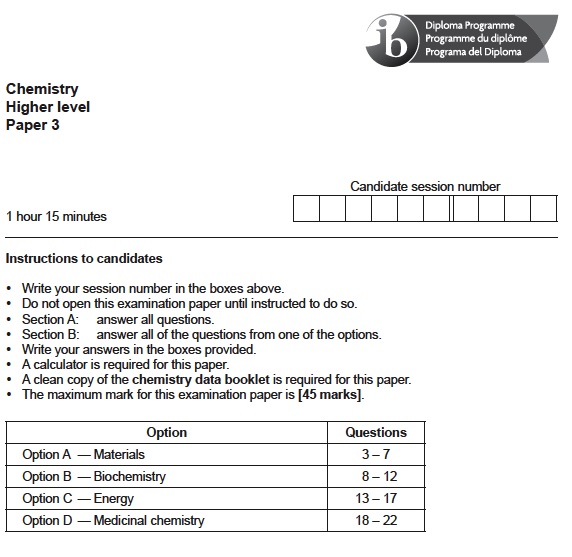Experimental work questions

 Examples of questions testing experimental work in Section A of Paper 3
Examples of questions testing experimental work in Section A of Paper 3
Basic information & comments
Although the prescribed practical areas do not form part of the Internal Assessment, questions can and will be asked on experimental work in Section A of Paper 3.

Cover sheet for HL Paper 3 © IBO
For both Standard Level and Higher Level Section A is worth 15 marks. Although the questions asked for HL could be completely different to the questions asked for SL it is has been the practice so far that the questions in each examination session are either identical or at least very similar for both levels. Section A essentially consists of two parts, one data response question and several short-answer questions on experimental work, although not necessarily in that order. The IB states that some of the questions in section A of Paper 3 may be related to the prescribed practicals or to experimental techniques in general. It also states in more detail "Section A of Paper 3 will include questions to assess the skills learned through the prescribed practicals". It is likely that questions on the Nature of Science will also be asked in Section A as it would be difficult to ensure parity for all of the NOS questions if they are asked in each of the four Options in Section B. It also the case that the Data response question will takes up about nine of the fifteen marks, which only leaves about six marks for the questions on experimental work. It is possible that some part-questions on experimental work could also be included in the data response question although the intention is to use published data rather than student generated data for the data response question.
As well as being limited to about five or six marks the questions on experimental work face one other limitation. There are no prescribed experiments as such, only prescribed areas or techniques, so the examiners cannot assume that all students will be familiar with the same practical experiment. They know that all students should be able to perform a titration for example, but they cannot assume that you will have performed an iodine/thiosulfate titration or an iron(II)/acidified manganate(VII) titration. Similarly although you should have performed an experiment to determine the molar mass of a gas there are many different ways of doing this so they cannot assume that all students would be familiar with every method. This means that the questions testing experimental work often need to have a stem giving some specific information about the experiment.
The sheets I have prepared for each practical (whether covering the mandatory laboratory components or other good practicals) all contain questions that test understanding. Provided you have been conscientious with your practical work, you should already have a good understanding of the necessary techniques and it is worth emphasising that the questions on Section A of Paper 3 can actually test very little in the few marks that are available.
The linked questions below for further practice are all worth six marks although probably in some cases I have asked you to do more to earn one mark than may be the case in the real IB exams. My rationale is that the more you understand the underlying principles and techniques of the particular experimental method the better prepared you will be. For this reason I have sometimes also asked you to calculate or confirm a result from the data presented as well as test your understanding of the principles. Most of the questions are suitable for both Higher Level and Standard Level but the final two, Question 8 and Question 9, contains concepts from the AHL so are suitable for Higher Level students only.

 IB Docs (2) Team
IB Docs (2) Team